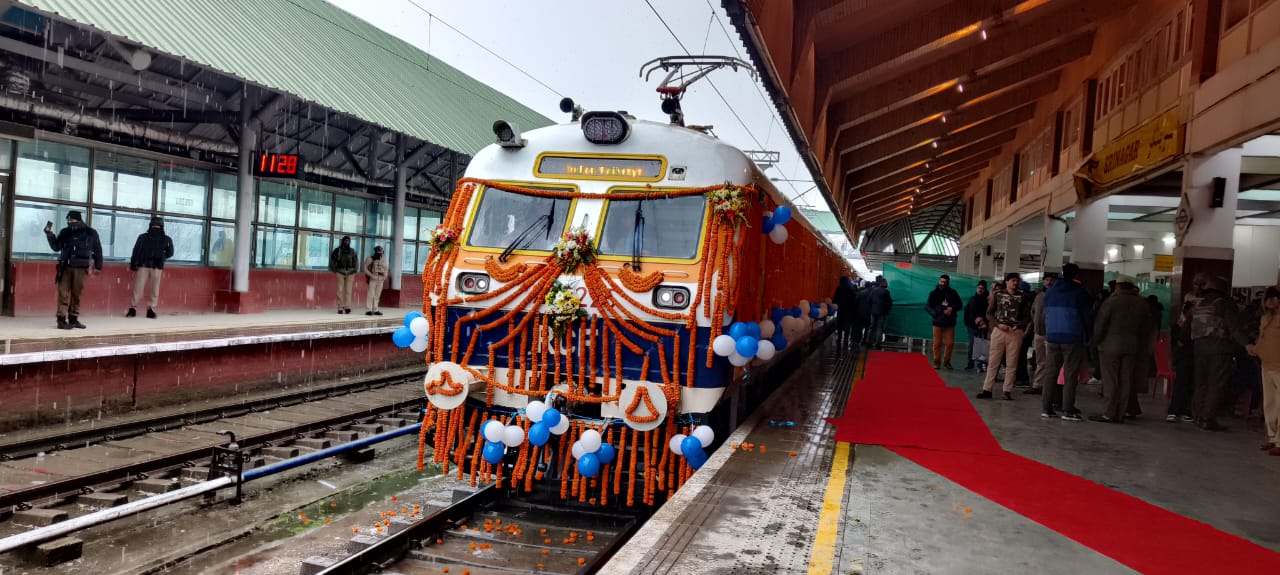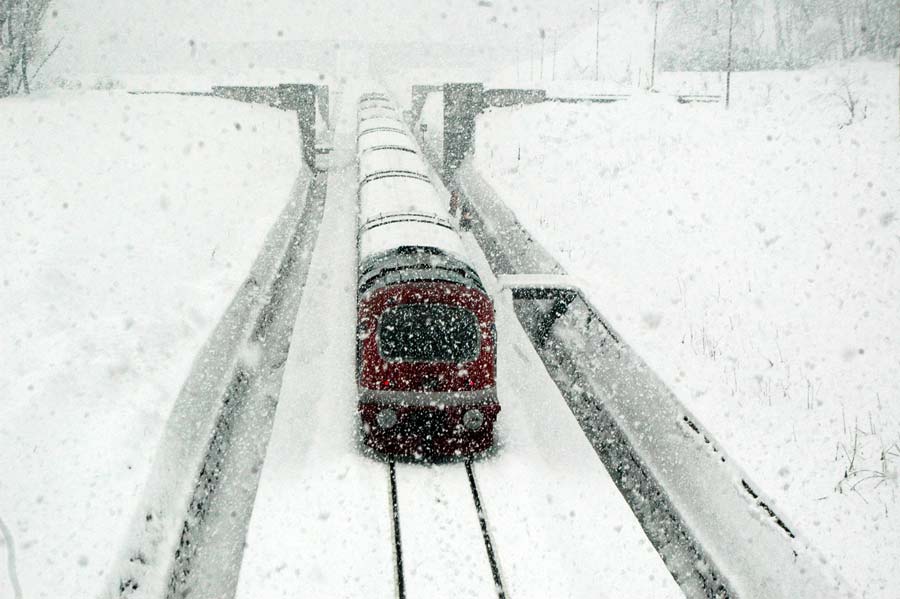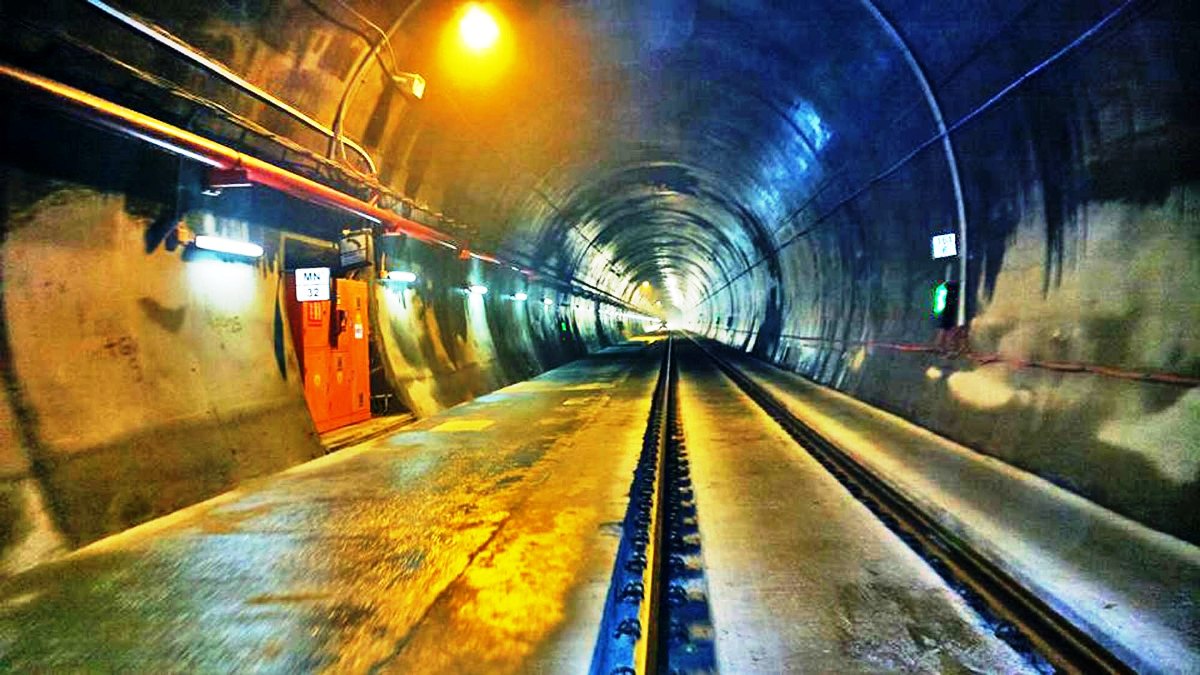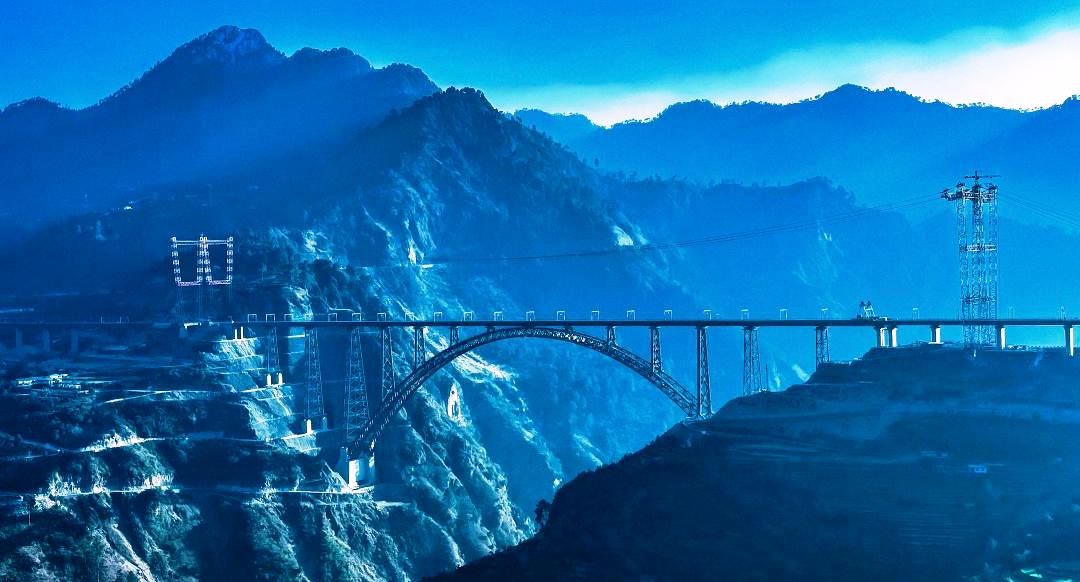As the prestigious track, a project of national importance became accessible from Baramulla to Sangaldan, Aiman Fayaz boarded the train, inaugurated by the Prime Minister, to record the historic four-hour-long drive
It was raining like cats and dogs and I had to rush through crowds and traffic snarls to ensure I did not miss the adventure of the day: to board the first train from Srinagar to Sangaldan, a God-forsakenGool belt that is hidden deep in the mountains. It was to be formally inaugurated by the Prime Minister, Narendra Modi virtually from Jammu.
As me and Umar Dar, the cameraman, finally reached the Nowgam Railway Station, driving a frequently interrupted 10-km distance, it was too crowded. Somehow we managed to park our vehicle as the space had a huge assembly of people within and around the station. There, it was a huge battery of reporters and broadcasters from local, national and international media, to cover the formal chugging of the electric train – the first in Kashmir. For the first time, I felt distinct in not being part of them as I had to board the train, as a passenger journalist. However, we ensured we picked the best of the formal inauguration.
Finally, we seated ourselves in the third compartment of the train, as the first two compartments were already occupied by security personnel accompanying Jammu and Kashmir’s five-time Chief Minister, Dr Farooq Abdullah.
Frozen Wagon
As the train finally started chugging on the tracks, the scene outside was enchanting, with the snow gradually blanketing the landscape in a pristine white and casting a serene silence all around. Despite being a native and accustomed to witnessing snow every winter, I could not help but be awestruck by the breathtaking beauty of my homeland. Not essentially the heaven, it seemed close to paradise.
The initial stretch from Srinagar to Awantipora unfolded at a leisurely pace. Hindered by the harsh weather conditions, the train struggled to find its rhythm amidst the snowfall.

Enchanted by the mesmerising scenery unfolding outside the train windows, the interior of the carriage held a contrasting narrative. As with many good things, our journey aboard Jammu and Kashmir’s first electric train was accompanied by an unexpected challenge: the plummeting temperatures inside the carriage. Despite the anticipation that had built up for months before its launch, we found ourselves shivering from the biting cold as the train made its way through the snow-covered landscape. With each passing moment, the chill within the train steadily rose, causing discomfort and making our hands and feet tremble. It felt, as if, the plot was going off the script for me as a passenger and for Northern Railway as the service provider.
We had an assignment at hand, however. Our focus shifted to the interior of the train where our reporting duties awaited. Cameras in hand, we rose from our seats and began capturing footage from the corner windows. Occasionally, we shot from the train door – that some excited passengers opened to have a better view, to capture the snow-covered landscape outside as it continued to accumulate with each passing moment.
Northern Railways is known for delays. We encountered our first halt at Awantipore, where we waited for almost half an hour. During this unexpected pause, we decided to have our packed lunch. However, to our surprise, the food we had brought along was frozen solid, making it impossible to eat. An empty stomach is a sign of hell. We had not eaten anything that morning before embarking on our journey. We remained optimistic, hoping to find something to eat at the next station.
Stranded Tourists
At Anantnag station, we were met with the sounds of excitement and cries. It turned out that nearly 150 non-natives from Mumbai had been waiting since morning, eager to board the train and make their way to Katra Jammu. As we had our identities dangling around our necks and cameras added to our identities, we were the first the stranded passengers wanted to talk to.
They bombarded us with questions about the route, eager to know if they would reach Jammu via Sangaldan. Despite my limited knowledge about the Jammu routes, I remained silent, deferring to Umer to reassure them that they need not worry and would indeed reach Jammu via Sangaldaan with the help of a local bus.
“Kashmir has always been our dream destination,” expressed Shelley, a non-local from Surat, Gujarat. “We have longed to experience the magic of snow first-hand for years. Little did we anticipate that instead of fulfilling our dream, the snow would become the very reason for us getting stuck in our hotel room, unable to venture out to places like Gulmarg and Sonamarg. It is truly heartbreaking to witness the beauty of the snow from the confines of the train interior, yearning to touch and feel its enchanting presence.”
The Kashmir Gateway
As we remained engaged in exchanges about cultures and politics among passengers representing diverse states, we did not realise that we reached Qazigund. For centuries, it has been sort of a gateway to Kashmir once people start getting in from Jammu. It leads to the perilous Banihal Pass where a 2.85 km tunnel was commissioned for the first time on December 22, 1956. It still did not make the passage easy.

Now the same mountain is paving the way for two long tunnels – the 8.45 km road tunnel which is part of the Jammu-Srinagar national highway and the 11.215-km Qazigund-Banihal railway tunnel. We were about to get into the latter tunnel that landed the train at the Banhal railway station.
Outside, large snowflakes fell gracefully from the sky, coating the windows with mist and obstructing our view. After a brief wait, a second halt was announced due to heavy snowfall ahead, delaying the train for over an hour. During this time, we ventured out, capturing scenic shots of snow-covered mountains and exchanging waves with locals on the nearby hills.
My newsroom in Srinagar was seeking details and when the delay protracted, we were advised to disembark the train and return to Srinagar. We refused as we were resolute in our determination to reach Sangaldan and then go home. The allure of capturing the entirety of the train route outweighed any apprehensions about the challenging conditions. We were committed to fulfilling our reporting assignment, unwilling to abandon our mission midway.
The Banihal Welcome
Finally, the train started moving. Not knowing the real adventure was now to start. We were supposed to pass through a chain of tunnels. The first one, the PirPanjal Railway Tunnel, stretched as long as 11.21 km. This tunnel stopped at the Banihal station. After many minutes, we could see a change in the surroundings.
The Banihal station was abuzz with excitement as residents eagerly awaited their very first train journey to Sangaldan. Banihal and Sangaldan fall in the sameRambandistrict but they are separated by almost a 90-minute uphill drive. Smiles adorned their faces, and laughter filled the train as they cleared snow from their Pherans and playfully brushed it from their hair.

Banihal has changed tremendously after the train started. It is a roaring business town where the real estate rates are as huge as in parts of Srinagar. New hotels have come up; too many shopping spots have emerged around the railway station. Over the years, it has emerged as a key halt for commuters. Owing to the perilous nature of the Banihal Pass, Banihal is etched in Kashmir’s memory and the contributions it has made in smooth travel on the highway deserve it to get the best of the change.
It has got the best of the train already. People moving from Srinagar to Jammu use the train to Banihal and then board the TATA Sumo and other transport. In certain cases, people move to Banihal, stay for the right and leave early either to Srinagar or Jammu. It may lose part of the glory once the train is through but until the Sangaldan-Katra is ready, it will continue reaping the benefits. Officials said it is possible only after the 2024 summer when the track will be through.
In Pitched Dark
After a brief halt, the journey resumed. Nothing much was visible outside as we were getting into a tunnel and then, moments later, entering another one.
Each time we entered a tunnel, the atmosphere inside the train changed. It went from bright to dark, like holding your breath for a moment before the train emerged into the light again. Tunnel T50 connecting Khari with Sumbarwas the longest one, spanning 12.77 kilometres. It is India’s longest railway tunnel. It was incredible to witness how they built such a long tunnel through the mountains that were usually seen from the skies while flying between Srinagar and Jammu – an engineering marvel indeed.
I attempted counting the tunnels, which were separated by brief sunny surroundings. In certain cases, it looked like those twilight moments. As I could not count, I gave it up. Then officials said there are 11 tunnels between Banihal and Sangaldan. The total distance between the two spots is 48.1 km and 43.37 km of them falls under tunnels. This means almost 90 per cent of the track is under tunnels. This stretch has 16 bridges (11 of them major) but it is very difficult to locate them as the train moves. In certain cases, I was told, it is a bridge connecting two tunnels.
Sangaldan Finally
After emerging from the final tunnel, we were greeted by the breathtaking scenery of Sangaldan. It was a beautiful sight after a long and challenging journey of four hours. As we pulled into the station, we were met with scores of people eagerly awaiting the arrival of the first fast train from Srinagar to their homes.
There was no time for enjoying the beauty of the spot as we had no option other than getting into reporting quickly. The idea was to ask people about their feelings of getting away from age-old inaccessibility. We had no idea about how soon the return train will start so we had to rush and get reactions.
A backward area, both economically and educationally, the Gool belt is expected to witness a lot of change with the train’s arrival. It is a region of lofty mountains and little avenues for work but is famous for Tata Pani, its hot Sulphur water spring, which otherwise draws crowds in winter for bathing, People believe a bath in the Sulphur spring helps cure skin and bone diseases, particularly Dermatitis and Arthritis.

Reactions were mixed. Most of the people we spoke to were excited about the improved connectivity and economic opportunities it could bring. A few, though appreciative of the gigantic infrastructure that took an investment of Rs15,863 crore, lamented over the ecological costs. Officials said part of the project is outside the track, which, among hundreds of kilometres of road includes three escape tunnels with a combined length of 30.1 kilometres.
“After two decades of anticipation, this moment is a dream come true,” Ali Mohammad shared joyously. “With over 14 years of effort, the train is now a reality. Our children can pursue their education without the need to leave home and stay in hostels. It is a joyous occasion for us.”
Amidst the celebrations of the train’s arrival, there were also scenes of nostalgia and sorrow for some. “We are indeed happy for the connectivity, but we cannot overlook the displacement from our homes and lands where we once farmed,” expressed Aqib, a local resident from Sangaldaan. “The train connectivity came at a cost to our livelihoods, a burden that went unreported.”
There were crowds, excited. Dr Farooq Abdullah who was on board, met with locals. He briefly spoke and congratulated people for getting the facility. Now, they will have daily connectivity with Kashmir, up to Baramulla, a distance of spans 185.66 RKM (route kilometres) involving 19 railway stations. The entire track’s electrification has cost the railways a whopping Rs 470.23 crore.
Tensions of Return
With basic reactions recorded, we found ourselves once again uncertain about our return journey to Srinagar. Umar swiftly made his way to the Loco Pilot’s Cabin, and upon receiving confirmation, we breathed a sigh of relief and boarded the train back to Srinagar. Despite encountering some challenges, we were relieved to have completed our report. This time, we found ourselves seated in the second bogey of the train, alongside Railway Army Personnel. Initially directed to the third coach, we asserted our presence by displaying our press cards, securing our rightful space for the journey.
On our journey back to Srinagar, the train came to another halt, this time at Banihal Railway Station, adding an extra hour to our travel time. Despite the delay, which extended the journey to four hours, the experience was filled with memorable moments.
Amidst the commotion and uncertainty of the train’s halts, I found solace in the beautiful scenes unfolding outside my window seat. Moreover, engaging in deep conversations about life with Umer added another layer of richness to the journey. Despite any challenges faced throughout the day, these meaningful exchanges made every hardship worthwhile. It was pitched dark as the train came to a grinding halt at Nowgam. It was a long trek on the track. But I never felt I was out of Kashmir. Everywhere people conversed with me in chaste Kashmiri, reasserting the reality that part of Kashmir lives on the other side of Pir Panchal.
The ultimate surprise was my editor was waiting to receive me. It underscored the significance of our journey and the stories we brought back.
















Asalaamualikum Aiman G
You make it seem so effortless, but I know you must have worked hard on this.Your hard work really paid off here…
Best wishes for your future projects…